-
Content Count
1,815 -
Joined
-
Last visited
-
Days Won
2
Content Type
Profiles
Forums
Calendar
Posts posted by Merthyr Imp
-
-
I suppose using the same criteria as for including the Skegness service you could also add the United Counties services to London via Loughborough and Leicester (MX1) and London via Northampton (MX5), as they ran several times every day. Although didn't use double deckers of course!
The MX1 was supposed to go via Loughborough and Leicester before joining the M1, but at busy times you;d often find two or three vehicles on the same departure - one calling at Leicester and missing out Loughborough, one doing the opposite, and one going straight to the M1 and missing out both.
-
As far as I can remember the following "ordinary bus services" ran from Huntingdon Street (omitting long distance express/coach type services). I have included Barton's route 9 to Skegness because it was a proper daily service, and on Summer Saturdays often used double deckers. I'd welcome any comments/corrections.
Trent :
62 Mansfield direct (i.e. via Newstead Abbey Gates)
63 (Joint with East Midland 12A) Chesterfield via Hucknall, Mansfield.
64 (Joint with East Midland 36) Doncaster via Edwinstowe, Worksop.
65 and 66 Loughborough via Ruddington and Bunny, also some via Rempstone and Wymeswold.
67 Arnold via Netherfield, Gedling and Mapperley Plains.
68 Stoke Bardolph via Netherfield.
69, 70, 71 Gedling via Netherfield.
73 and 73A (Joint with Skills) East Bridgford via Radcliffe and Shelford
74 and 75 Carlton, Burton Joyce, Lowdham and Gunthorpe. (Not sure about route numbers)
79 (Joint with Lincolnshire Road Car 33C) Grantham via Radcliffe, Bingham, Bottesford, Aslockton.
79A Bingham via Radcliffe.
80 (Joint with East Midland 37) Retford via Edwinstowe, Ollerton.
84 Sutton in Ashfield via Hucknall.
You perhaps ought to include the Trent/North Western joint service to Manchester - the X2.
Although it was a long distance service you actually bought your ticket from a conductor on the bus in the ordinary way (unlike with Barton's Skegness service where you had to go to the booking office). It was also a regular daily service several times a day.
-
There were three Bartons services running north from Huntingdon Street. The 7 and 7A took the same route as far as Woodborough - i.e. Union Road, York Street, (possibly Mapperley Road, then) Woodborough Road, Plains Road, Mapperley Plains, Spring Lane to Lambley and Woodborough. The 7 then turned right and went to Epperstone. the 7A turned left to Calverton, with a few journeys going on to Oxton. The other route was the 8 which went straight up Mansfield Road, and direct to Oxton.
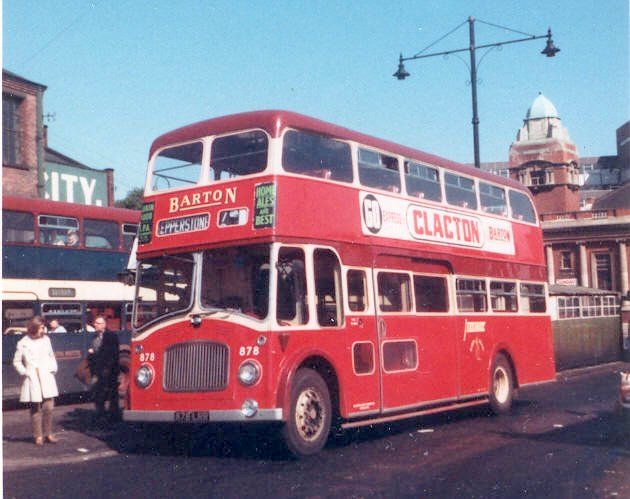
Here's a photo of Barton 878 (one of their part home-made/part Leyland vehicles) on an Epperstone service in the 1960s.
-
I'm afraid the route map has a couple of bits of green line missing. One is the section of King Edward Street from Huntingdon Street to Lower Parliament Street, which was used by the 38/39 and 44 as well as the 40/47. The other is the George Street, Victoria Street section, where the streets are shown, but not the green line. I have seen a published photo as early as 1930 showing a 40 trolleybus turning from Lower Parliament Street into George Street (a sharp bend that had to be taken gently if you didn't want trolley poles waving about in mid-air!)
The route of the 40 began at Wells Road/Kildare Road, then via St Anns Well Road (the 47 began at Ransom Road), King Edward Street, Lower Parliament Street, George Street, Victoria Street, The Poultry, South Parade, Wheeler Gate, Albert Street, Lister Gate, Greyfriar Gate, Canal Street, Wilford Street, Wilford Road to Wilford Bridge. In the opposite direction, the route through the city centre was Long Row Central, Queen Street, Lower Parliament Street.
Regarding the bend into George Street from Parliament Street, it was always said that it was the reason why the 40 could only be worked by the 4-wheel trolleybuses - the 6-wheelers couldn't make the turn due to their extra length.
-
I don't think that type of spoon was for putting loose tea into the pot, you would have a small caddy spoon for that.
This type of spoon was for mashing loose tea in a cup or mug, before teabags were widely available.
You would put a small amount of tea in, clamp it shut, then pour your water in - and hopefully it mashed!
I've still got one of those! My wife sometimes uses it for making a cup of herbal tea.
-
Merthyr Imp,
Which was the cafe that had its windows painted half way up so that you could not see out if sitting down, except for the sky and those outside could not see in unless standing right outside?
Think the paint might have been yellow? and there was an entrance next door to the cafe that the bus crews used to go in - possibly for rest rooms, directions for the next trip etc?
I'm afraid that doesn't mean anything to me. The only cafes I can remember (this is 1962 onwards) were 'Hughie's'(?) at the top of the bus station - where you could sit on stools and look out of the window, which was why we bus spotters favoured it - and Capocci's(?) the other side of Huntingdon Street. Actually, for all i know it could be that place you're referring to as I have only vague memories of it.
I don't know if there was a cafe - which might have been used by bus crews in the area in the bottom corner (where Gash's buses used to leave from), where there was a sort of waiting room and toilets (I think).
-
wasent the building behind the 63 bus a cafealso one on opposit side of huntingdon st
The black building on the corner was Trent's booking office. Just to the right of that was a cafe - was it a branch of Capocci's? Can't remember. Went in it occasionally, but preferred the one at the top of the bus station.
-
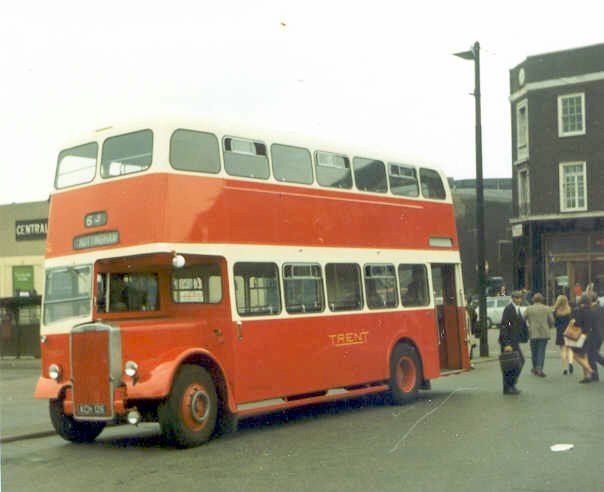
Here's a photo of Trent Leyland Titan PD2 no. 783 on a 63 that's evidently just arrived at Huntingdon Street. It's possibly going out of service as it hasn't gone into the platform for the return journey.
I think I've got a photo of a 62 taken at Sherwood, but I'll have to dig it out. I've got boxes of bus and railway photos and slides in the attic, but I've only got some of them scanned into the computer.
Any photos I put on this forum are all my own unless I say otherwise.
I did say under the previous two: 'taken with my old Instamatic camera'. Did anyone else have one of those? No messing about with threading in roll films, you just dropped in a cartridge. Drawbacks were a slow shutter speed and the square picture format. I can't remember if you could get black and white film for them, but I only used colour.
-
Having caught up with this thread here's a couple of photos from me to be going on with:
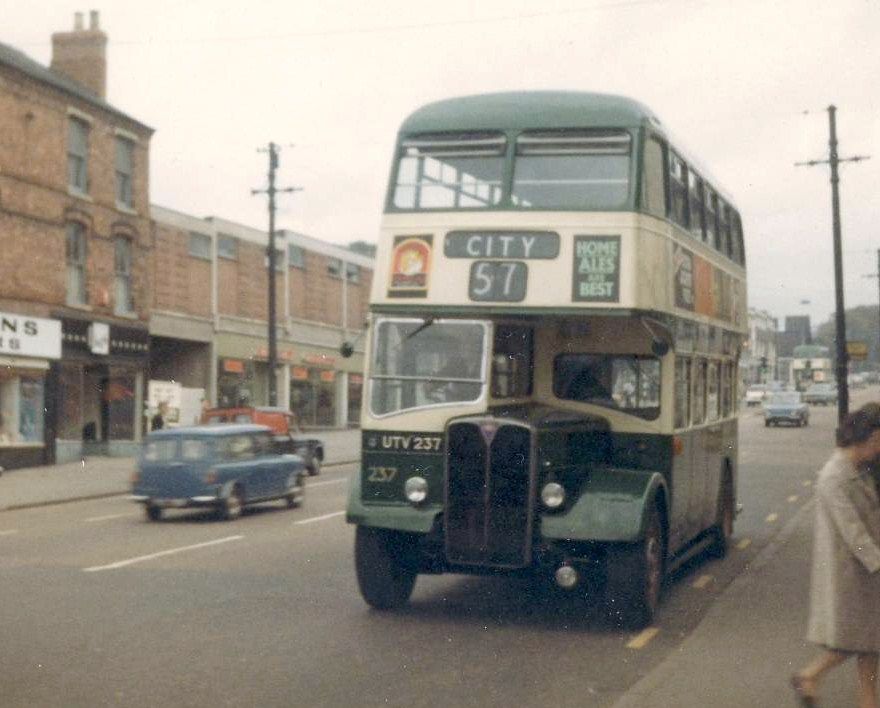
This is NCT AEC Regent V no. 237 on Mansfield Road, Sherwood.

And here's a line-up of West Bridgford AECs on South Parade.
Sorry if the picture quality is not great. These were taken with my old Instamatic camera (probably around 1968).
-
 2
2
-
-
There were single deck versions also, they have appeared on this forum before were it was wondered if they were dual fuel buses, but the bonnet only covers the electric equipment.
https://www.hpacde.org.uk/picturethepast/jpgh_derbyshire/DCCS000068.jpg
https://www.hpacde.org.uk/picturethepast/jpgh_derbyshire/DCER000516.jpg
https://www.hpacde.org.uk/picturethepast/jpgh_derbyshire/DCCS000069.jpg
https://www.hpacde.org.uk/picturethepast/jpgh_derbyshire/DCCS000067.jpg
https://www.hpacde.org.uk/picturethepast/jpgh_derbyshire/DCCS000005.jpg
One give-away is that there is no hole in the lower middle part of the 'radiator' for a starting handle! In fact, motor buses of that era would often run about with the starting handle inserted.
-
Hi Cliff Ton, you really are an Ace at retrieving old photos and some of these certainly bring back memories:
as a child it was quite a treat during the fifties to sit upstairs on the number 22, Hanley Street and take a look down at the Alms Houses opposite. Behind a high, brick wall a long, front garden was beautifully maintained and there were ample trees to give a bit of shade to any of the occupants choosing to sit out on one of the garden seats. These Alms houses were later to become another example of Nottingham's valuable architecture knocked down, rather than considered and preserved for future generations.
Whilst travelling home on a packed bus the other evening, it was unfortunate that the bus had to bypass some prospective passengers at their bus stops. I got talking to a couple of ladies of a similar age about the old double deckers: we were trying to work out how many passengers these buses could take when packed; we reckoned about eighty - with the fifteen allowed standing downstairs.
Well, in the 1950s the fairly standard number of seats on a double decker was 56, with - officially! - 8 standing downstairs.
When the modern rear-engined, front entrance double deckers were first introduced in the early 1960s they had 77 seats.
-
I always thought it was Mackemsons, or Makemsons, either way, it had an M in it.
It was Makemson's in Bulwell. Their garage was on the corner of Highbury Road and Piccadilly. I forget when they ceased operations - but I think it was before 1980. Last time I was around that area was in 1997 and the building that was their garage was in use for something else.
-
If you are as sad as me, some of you might like to hear what one of these little 29 seater Bedfords sounded like. Try this for size :
That took me back! When I was very young, in the 1950s my dad used to drive buses like that when we lived in Lincolnshire (getting off topic for this Forum!). That clip almost sounded louder than the real thing used to - they had petrol engines, whereas most buses by the time those Bedford were being made (late 1940s) were diesel. When starting cold in the morning and backing out of the garage I remember the engine would make a sort of spitting cough noise, which I'm led to believe was due to water in the carburettor.
That gearbox whine was so distinctive!
-
The Manchester service was the X2. I may have a photo or two of my own somewhere about, but here's one taken at the Victoria bus station a year or two after the time I was describing:
http://www.flickr.com/photos/21940361@N08/8240818869/
Regarding trainspotting, it was the end of steam that lost my interest in that, for a while at least, causing the change to buses instead.
-
It's amazing to think what a busy place the Huntingdon Street area used to be, with the bus station, the central market, the proximity to Victoria Station, it was a hive of activity. Today it's virtually a dead area!
To anyone who has a good knowledge of bus services then, am I correct in thinking that the Trent services coming in from Mansfield and Sutton used to turn off right, down Glasshouse Street, so that they could drop people off at the back of Vic Station?
I'm pretty sure that all the services that came down Mansfield Road went down Huntingdon Street itself. I don't ever remember any bus service along Glasshouse Street.
-
Glad you enjoyed your hobby in the sixties...personally...I was more interested in Crumpet...much of it wrestled to the rear seat of your buses.My memories are just as vivid as yours, but must admit never noticed the make of the bus at the time... :tongue:
And I don't imagine you're referring to pyclets either!
-
 1
1
-
-
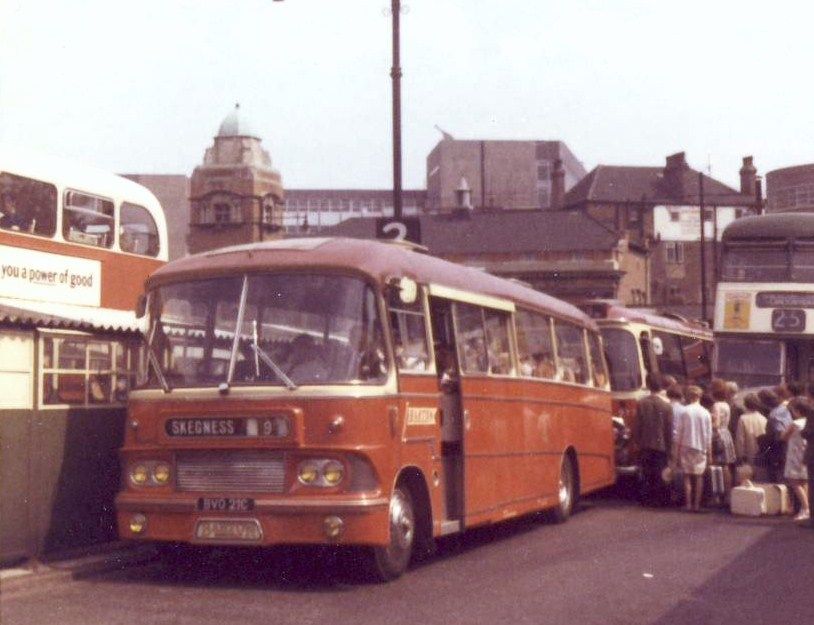
This is Barton 1021 all set for Skegness, probably with the vehicle behind it also going there.
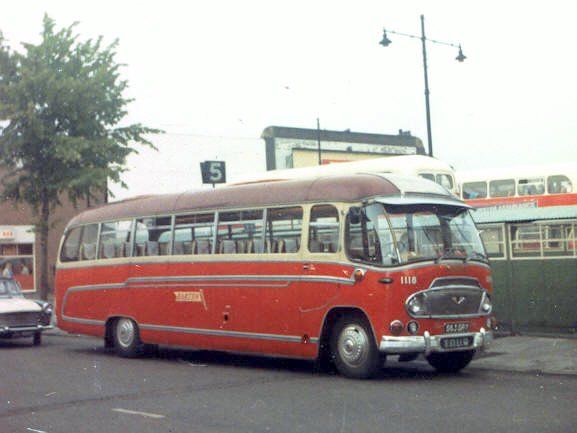
No. 1118, a second-hand vehicle, parked on Huntingdon St itself. Behind the tree on the left can be seen part of the cafe ('Hughie's') mentioned.

Trent no. 56, with the Central Market in the background. To its right on the corner is the Trent booking office.
-
 2
2
-
-
Confessions of a Bus Spotter
At the risk of boring people here's some reminiscences from me.
In my bus spotting days in the 1960s I spent literally many happy hours at Huntingdon Street on summer Saturdays. In those days, although use of private cars was increasing rapidly a great many people still went on their family holidays by coach, and to a bus enthusiast in Nottingham, Huntingdon St. on a Saturday during the school summer holidays was the place to be.
My friend and I would usually get there before 7am (I think 6.30 was the earliest I ever managed) in order to see the early departures to places like Great Yarmouth, and we'd still be there up to around 7pm to 8pm that night. Until about 9am the top part of the bus station was used solely for the various coach services, and all the local buses had to cram into the lower half.
In the early morning period there would also be the coach tour holiday departures by Trent and Barton, but they would leave from the other side of Huntingdon St from outside the companies' booking offices.
The busiest time for the coach services was until 9.30am, then there were further peak periods of activity around 11.30, 2.30pm and 4.30pm.
Some of the main destinations:
Trent ran to Clacton, Felixstowe, Barry Island, Blackpool, Cromer, Great Yarmouth, Cleethorpes, Sutton-on-Sea, Southend and Skegness.
Barton to Llandudno, Tenby, Morecambe, Southport, Pwllheli, Aberystwyth, Redcar, Blackpool and Skegness.
Skills to Scarborough, Bridlington and Filey
Lincolnshire Road Car to Mablethorpe and Skegness.
United Counties to Northampton and London.
There was also the long distance bus service to/from Manchester operated jointly by Trent and North Western which was extended to Skegness in the summer.
Then there were long distances services passing through::
Hall Bros (later taken over by Barton) from Tyneside to Coventry.
'Yorkshire Services' (West Yorkshire, Yorkshire Traction and East Yorkshire) from places such as Keighley, Leeds and Bradford to Northampton and Birmingham.
'Associated Motorways' (a combination of companies, but mainly Black & White) to Cheltenham, Paignton and Weymouth.
So that's 11 different companies to start with, plus these would often hire in coaches from other companies. Then there was the morning departure to Northampton which was invariably worked by a Royal Blue coach, and one of the early evening Cheltenham arrivals would usually produce a Southern National vehicle.
Other bus enthusiasts would be seen at various times through the day, but I think my friend and I were the only ones who put in a 12-hour+ shift! The 9.30am lull would mean a chance for something to eat at the cafe at the top of the bus station (was it called 'Hughie's'?), and there would usually be another visit or two there during the day - it was also the only chance to sit down, until some benches were installed on the Huntingdon St side of the shelters in later years (1969-ish).
After the last peak time had finished, at around 5pm we'd have a walk down to the NCT and Trent depots down Parliament St, as in the latter there was usually a Southdown coach to be seen, stabled overnight on a coach tour from the south coast. After that we began to see the coaches that had left in the morning for places such as Skegness arriving back again! But there were still two or three Black & White services arriving from the south west to see.
All the variety that made it worthwhile and interesting came to end with the formation of the National Bus Company and National Express, when more or less all the big company coaches began to be painted white. That was also when Huntingdon St closed, and the new Victoria Bus Station began to be used instead - never spent all day there, as the great days were over.
As well as the coach services, you could of course see bus services from all the following at Huntingdon St.: Barton, Trent, Midland General. Mansfield District, NCT, Skill's, South Notts, Gash and East Midland.
As I say, when all the variety went at the end of the 1960s so did all the interest for me.
-
 2
2
-
-
To this day when talking to people who knew Nottingham in those days and referring to that entrance to the Broadmarsh Shopping Centre I still say 'Where Drury Hill used to be.'
And even years after the Victoria station was demolished I still kept referring to the other one as 'the Midland station'.
-
Hey Beefy I know exactly what you mean by the smell of Bell Punch tickets.
The Twelve Journey tickets came in before the switch to Autofare in the early 70s. There was a yellow ticket cancelling machine just inside the front entrance on the right hand side. That was why for several years NCT buses had front doors that opened to the centre rather than the side.
The ability to jump the queue was the only reason for buying a ticket as there was no advance purchase discount.
With those Twelve Journey tickets, the cancelling machine would chop a piece off at the side each time, similar to those Felix tickets shown on an earlier post. There was space for 12 bits to be snipped off, but if you were careful about inserting the ticket into the machine and only did so barely enough for it to operate you could squeeze a 13th journey out of it!
-
-
A couple of comments picking up on earlier postings:
The Barton non-stop service to Derby was the X42.
I think Nottingham was just about the furthest north that Midland Red services reached, but they did run to Grantham from Leicester.
In my bus-spotting days my friend and I, or sometimes on my own, used to get a Midland Red 'Day Anywhere' ticket for 12/6 which gave you unlimited travel for the day on any of their buses. In earlier days it was a thing like a playing card, and you had to buy it what I think was the Trent booking office at the bus station. I think I've still got one somewhere, but I can't lay my hands on it at the moment.
I'm hopefully attaching a photo of one the many second hand double deckers that Barton back then.
-
Here's a photo of one with some details:-
http://www.old-bus-photos.co.uk/?cat=160
I'm pretty sure they did first enter service on the 68, as I remember going on one to Clifton and back when they were new for the sake of it - a whole 4d each way! By the way, unlike front entrance buses today where you pay the driver as you get on they still had conductors on them in those days.
They then became regulars on the 49 and I would travel on them to school and back.
-
 1
1
-
-
I think the main problem with building a bridge for the Lincoln line over the "East Coast Main Line" is the river Trent & canal lock.
And I don't think the volume of traffic on the Lincoln route would justify the building of a bridge.
But as I said, they built the A46 bypass road bridge very close by - see here for a photo of it, with the railway beyond it leading to the flat crossing.
http://www.flickr.com/photos/jondave/4432545506/
It would surely have been a lot simpler in the long run to build a combined road and rail bridge when they did that instead of now having the problem of trying to fit a separate rail bridge in at that height as well (the road also goes over the main line).
I believe a flyover is still in Network Rail's long term plans, but I don't know if it will happen. I think it's not so much the idea of increasing capacity on the Nottingham - Lincoln line as getting rid of the speed restriction over the crossing on the main line.





Railway Photos
in Pete's Nottingham Transport Forum
Posted
That photo must have been after my time (don't remember seeing diesels through there), but that view of the tunnel brings some memories back.
The rat hole was were we trainspotters at High Pavement school used to go at lunch time - at least we did when I was one of them in the 1961/62 period. Lunch time then was from 1230pm to 2pm, and after school dinner (one shilling a day) a few of us could usually be found on Arnold Road at the point where the rat hole line went underneath, with of course the main line next to it on the bridge over the road. We seldom bothered going further down to where the bridge carrying the Bagthorpe Junction to Basford North link also went over the road - probably because it was more fun to see the trains come out of the rat hole.
As I remember, we never seemed to have more than half an hour there. My recollection is that there was a train out of the rat hole at 1.35pm (which we called 'the twenty five to rat hole), and when another one came through at 1.50pm it was the 'ten to rat hole' and time to set off back to school. Now that's how I remember it, but it does seem a little strange that there whould be two Derby - Nottingham trains within 15 minutes of each other, and it would be interesting to see a timetable of the period. I don't remember ever being late back to school, so the timekeeping of the 'ten to' must have been pretty reliable!
At that time the rat hole passenger trains were worked by L1 2-6-4Ts. On the main line, as well as the usual 9Fs, 2-8-0s, etc the highlight was seeing the York - Bournemouth go through - at least that's we called it, but as it was northbound it would have actually been the Bournemouth - York! It would include some green Southern Region coaches and was pulled by a B1 - a regular performer being one of the named engines, 'Fitzherbert Wright'.
On the main line, as I've written in another thread, we would see brand new Hymek diesels heading south on their way from Beyer Peacock in Manchester to the Western Region via the Woodford to Banbury line. In the earlier days of the period I've mentioned we would frequently see J39 0-6-0 no. 64798 go hurrying past, as often as not light engine - I don't know if it was perhaps used on some sort of pilot duty between Victoria and Annesley or Bulwell or something, but it was such a regular sight it would draw cries of 'scrap it!'. If only we'd known...
From the classroom windows of High Pavement, especially the top floor, we had a panoramic view, with the Great Central main line in the distance, tantalisingly offering remote glimpses: "Is it a Brit'?" - "Nah - just a 92-er!" And along the bottom of the slope down to Arnold Road we could see the white plume of smoke whenever a goods train plodded past - although as Mapperley Tunnel was closed by that time they would have been going no further than Daybrook.
Away from school, we had moved to Sherwood in the summer of 1961, and I would often spend time trainspotting on Perry Road bridge. The alternative would have been the bridge over Haydn Road at New Basford station (spotters were frowned upon on the station itself!), but the line being on an embankment there the view wasn't as good as looking down from the bridge at Perry Road. The highlight in the evenings was seeing the fish train from Grimsby come through at about 7.30pm as at that time it was hauled by a Britannia 4-6-2 - a namer! 'Rudyard Kipling' was the most frequent performer, but I remember also 'copping' 'Thomas Hardy' there. Not long before the fish train was due there was a regular working by an ex-LMS 8F. Non-Eastern Region engines were still something of a rarilty at that time, unlike a year or two later.
Another memory is of when exploring the area after our move to Sherwood I came across the disused Sherwood station (which up to that time I had never known existed). This was before the blocks of flats were built on the site, and the platforms at least were still there. I also once (accompanied by an adult) walked through Sherwood Tunnel, which wasn't fenced off or anything.